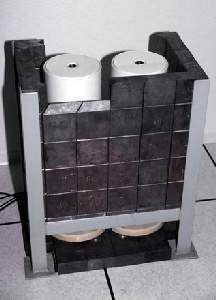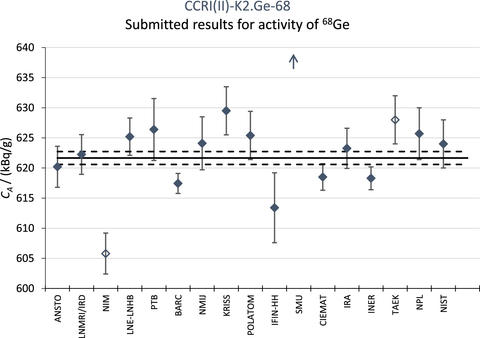Summary
To establish equivalency of activity standards with national metrology institutes (NMIs) around the world and support their declarations of calibration and measurement capabilities, the NIST Radioactivity Group participates in a variety of formal and informal comparisons. NIST pilots and participates in formal comparisons organized by the Bureau International des Poids et Mesures (BIPM) and the International Conference on Radionuclide Metrology (ICRM). Informal bilateral comparisons with other NMIs are also a common practice.
Description

The International Reference System (SIR) is this pair of ionization chambers at the Bureau International des Poids et Mesures (BIPM).
The NIST Radioactivity Group pilots and participates in a variety of different comparison activities.
The BIPM’s Consultative Committee on Ionizing Radiation (CCRI) organizes formal comparisons (“key comparisons”) of long-lived radionuclides through its Key Comparison Working Group (KCWG-II). As defined, a key comparison is one of a set of comparisons selected by a Consultative Committee to test the principal techniques and methods in the field of ionizing radiation. NIST scientists play a major role in steering the activities of the KCWG-II, and NIST has often served as the pilot laboratory for comparisons. NIST has recently participated in key comparisons for Ge-68 (NIST pilot), Pu-241, Tc-99, Cd-109, and SIM piloted Zn-65.
The BIPM is also home to the International Reference System (SIR), a pair of reentrant ionization chambers used for indirect comparison of activity standards for long-lived gamma-ray emitting radionuclides. Laboratories from all over the world, including NIST, submit flame-sealed ampoules to the SIR for measurement. The ionization chamber response is measured relative to the submitting laboratory’s stated activity. A derived SIR equivalent activity can then be compared with results from other laboratories that have submitted the same radionuclide. This allows comparisons of activity standards without the need to share material and can often span many years. Recent NIST submissions to the SIR include Ge-68/Ga-68, Co-57, Co-60, Ba-133, Gd-153, and Ac-225.
NIST measurement results for Key Comparisons, including SIR comparisons, can be found in the Key Comparison Database (KCDB) maintained by the BIPM.
The new Extended International Reference System (ESIR) has been established. This system will allow comparisons of activity standards for beta-emitting radionuclides. It will be based on liquid scintillation counting using the triple-to-double coincidence ratio (TDCR) method. Scientists from the NIST Radioactivity Group have been deeply involved in the development of the ESIR and participated in the Co-60 pilot comparison by submitting a NIST-calibrated source.

For shorter-lived radionuclides, shipping radioactive sources from one laboratory to another is impractical. To meet this challenge, the BIPM developed the SIR Transfer Instrument (SIRTI). BIPM scientists travel to laboratories with a NaI(Tl) detector to measure sources prepared and calibrated specifically for the comparison. NIST has hosted the SIRTI twice, once participating in the comparison for Tc-99m, and the second time participating in the comparisons for F-18, and Cu-64.
Less formal bilateral comparisons between laboratories can be achieved via exchange of material or via comparison of measurement data (e.g., ionization chamber responses). Recent examples include a comparison of activity measured by liquid scintillation counting of C-14 with the National Research Council (NRC) Canada and a comparison of activity standards, measured half-lives, and measured gamma-ray emission intensities for Ra-224 with the National Physical Laboratory (NPL) of the United Kingdom.

